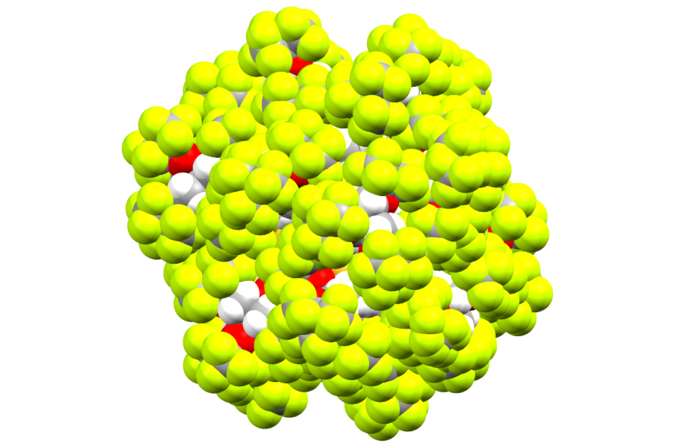For the first time, the SupraBioNano Lab (SBNLab) at the Politecnico di Milano’s Department of Chemistry, Materials, and Chemical Engineering “Giulio Natta,” in collaboration with the University of Bologna and the Aalto University of Helsinki (Finland), has produced a superfluorinated gold nanocluster with a core of only 25 gold atoms and 18 branch-structured fluorinated molecules.
 Representation of the nanocluster. Image Credit: Politecnico di Milano.
Representation of the nanocluster. Image Credit: Politecnico di Milano.
The research was published in Nature Communications, a prominent magazine.
Metal clusters are a novel class of very complex nanomaterials with ultra-small dimensions (less than 2 nm) and unique chemical-physical features such as luminescence and catalytic activity, which stimulate their use in a variety of scientific domains critical to today’s global concerns.
Metal nanoclusters are employed as new probes for diagnostic and therapeutic applications in precision medicine, and they are also used as efficient catalyzers for the creation of green hydrogen in the energy transition.
The crystallization of metal nanoclusters allows for the production of high-purity samples and the identification of their fine atomic structure; nevertheless, this is presently a challenging process to regulate.
The approaches used in this work helped nanoclusters crystallize, enabling their atomic structure to be studied using X-Ray diffraction at Trieste’s Sincrotrone Elettra. The end result is the structural description of the most complex fluorinated nano-object ever reported.
Thanks to the presence of a completely fluorinated shell, containing almost 500 fluorine atoms, the gold nanocluster is stabilized by the numerous interactions between the fluorine atoms of the binder, encouraging crystallization.
Giancarlo Terraneo, Associate Professor, Department of Chemistry, Materials and Chemical Engineering, Politecnico di Milano
It will soon be possible to study the structure of these advanced nanomaterials at the Politecnico di Milano, where—thanks also to the grant from the Region of Lombardy—Next-GAME (Next-Generation Advanced Materials), a laboratory dedicated to the use of state-of-the-art x-ray instruments to characterize crystals, nanoparticles and colloids, is being established.
Pierangelo Metrangolo, Professor, Politecnico di Milano
Dr. Angela Acocella and professor Francesco Zerbetto of the University of Bologna’s “G. Ciamician” Chemistry Department used quantum chemistry techniques to rationalize the connections between the fluorine atoms both within the nanocluster and between the nanoclusters.
Professor Valentina Dichiarante, Professor Francesca Baldelli Bombelli, Dr. Claudia Pigliacelli, and Professor Giulio Cerullo from the Politecnico di Milano’s Physics Department also contributed to the research, which looked at the optical characteristics of the nanocluster and demonstrated the fluorinated binders’ influence on the gold core’s optical activity.
Journal Reference:
Pigliacelli, C., et al. (2022) High-resolution crystal structure of a 20 kDa superfluorinated gold nanocluster. Nature Communications. doi:10.1038/s41467-022-29966-2.